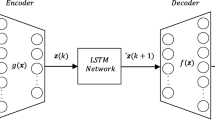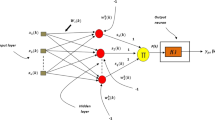Abstract
Deep learning methods have been widely studied in system modeling due to their strong abilities in feature representation and function fitting. However, most deep learning models are end-to-end black box models, and some key information of the system (such as time delay) cannot be obtained. This paper proposes a grey box model that combines discrete bayesian optimization (DBO) and controlled recurrent neural network (CRNN), namely CRNN-DBO model, aiming at modeling and time delay identification for time delay systems. CRNN is introduced and learns to map the relationship between input data and output data by backpropagation algorithm, while the unknown time delays are modeled as hyperparameters of the mask layer in the CRNN model which are identified by DBO method. The backpropagation algorithm and the DBO method are combined to find the minimal loss value of the model, and the correct time delays as well. To ensure the convergence of the DBO method, l2 regularization term of the mask layer is added in the loss function. The effectiveness and robustness of the model are verified through simulation in the situations of short time delay, long time delay, and nonlinear time delay system. The results indicate that time delays are accurately identified, and the prediction error is smaller than other models.

















Similar content being viewed by others
References
Normey-Rico JE, Camacho EF (2007) Control of dead-time processes. Springer, London
Wu H, Tsakalis KS, Heydt GT (2004) Evaluation of time delay effects to wide-area power system stabilizer design. IEEE Trans Power Syst 19(4):1935–1941
Richard JP (2003) Time-delay systems: an overview of some recent advances and open problems. Automatica 39(10):1667–1694
Barreto GA, Souza LgM (2016) Novel approaches for parameter estimation of local linear models for dynamical system identification. Appl Intell 44(1):149–165
Yang Y, Yang B, Niu M (2017) Adaptive infinite impulse response system identification using opposition based hybrid coral reefs optimization algorithm. Appl Intell 48:1689–1706
Jiménez EC, Díaz P, Ávalos O, Zaldivar D, Cisneros M (2017) Nonlinear system identification based on anfis-hammerstein model using gravitational search algorithm. Appl Intell 48:182–203
Singh S, Ashok A, Kumar M, Rawat T (2018) Adaptive infinite impulse response system identification using teacher learner based optimization algorithm. Appl Intell 49:1785–1802
Li J, Zheng Y, Lin Z (2014) Recursive identification of time-varying systems: Self-tuning and matrix rls algorithms. Syst Control Lett 66:104–110
Qiang LIU, Jia-chen MA (2016) Subspace-based identification of discrete time-delay system. Front Inf Technol Electron Eng 17(6):566–575
Liu Y, Ding R (2013) Consistency of the extended gradient identification algorithm for multi-input multi-output systems with moving average noises. Int J Comput Math 90(9):1840–1852
Sharma S, Padhy PK (2020) A novel iterative system identification and modeling scheme with simultaneous time-delay and rational parameter estimation. IEEE Access PP(99):1–12
Bedoui S, Ltaief M, Abderrahim K (2013) A new generalized vector observation for discrete-time delay systems identification, pp 1922–1927
Bedoui S, Ltaief M, Abderrahim K (2013) Hierarchical gradient based identification of discrete-time delay systems, pp 4565–4570
Chen F, Liu T (2017) Iterative identification of discrete-time output-error model with time delay. J Central South Univ 24(3):647–654
Chen J, Ma J, Liu Y, Ding F (2017) Identification methods for time-delay systems based on the redundant rules. Signal Process 137:192–198
Higo T, Kawaguchi T, Itamoto M, Adachi S (2018) Recursive identification of fractional time-delay systems using discrete-time model. IFAC-PapersOnLine 51(15):939–944
Ghanes M, Deleon J, Barbot JP (2016) Simultaneous observation and identification for nonlinear systems under unknown time-varying delays. J Frankl Inst-Eng Appl Math 353(10):2305–2318
Bayrak A, Tatlicioglu E (2013) Online time delay identification and control for general classes of nonlinear systems. Trans Inst Measur Control 35(6):808–823
Li J, Zong T, Lu G (2021) Parameter identification of hammerstein–wiener nonlinear systems with unknown time delay based on the linear variable weight particle swarm optimization. ISA transactions
Tlili AS (2021) H\(\infty \) optimization-based stabilization for nonlinear disturbed time delay systems. J Control Autom Electr Syst 32(1):96–108
Wang D, Wang Z, Chen M, Wang W (2018) Distributed optimization for multi-agent systems with constraints set and communication time-delay over a directed graph. Inf Sci 438:1–14
Li C, Yan H (2017) Nonlinear time-delay system identification based on multi-dimensional taylor network and ipso. In: 2017 International Conference on Grey Systems and Intelligent Services (GSIS)
Li C, Yan H (2018) Identification of nonlinear time-delay system using multi-dimensional taylor network model. In: 2018 IEEE International Conference on Manipulation, Manufacturing and Measurement on the Nanoscale (3M-NANO)
Ren XM, Rad AB (2007) Identification of nonlinear systems with unknown time delay based on time-delay neural networks. IEEE Trans Neural Netw 18(5):1536–1541
Wang YH, Zhao YD, Hao XJ, Cheng PX (2008) Time-delay identification for linear multi-input multi-output system. In: World Congress on Intelligent Control & Automation
Shahriari B, Swersky K, Wang Z, Adams RP, De Freitas N (2016) Taking the human out of the loop: A review of bayesian optimization. Proc IEEE 104(1):148–175
Luong P, Gupta S, Nguyen D, Rana S, Venkatesh S (2019) Bayesian optimization with discrete variables. Springer International Publishing, Cham, pp 473–484
Rasmussen CE (2003) Gaussian processes in machine learning. In: Summer School on Machine Learning. Springer, pp 63–71
Srinivas N, Krause A, Kakade SM, Seeger M (2012) Information-theoretic regret bounds for gaussian process optimization in the bandit setting. IEEE Trans Inf Theory 58(5):3250–3265
Liu Y, Tao T (2015) A cs recovery algorithm for model and time delay identification of miso-fir systems. Algorithms 8(3):743–753
Yang S, Gao T, Wang J, Deng B, Lansdell B, Linares-Barranco B (2021) Efficient spike-driven learning with dendritic event-based processing. Front Neurosci 15:97
Lobov SA, Mikhaylov AN, Shamshin M, Makarov VA, Kazantsev VB (2020) Spatial properties of stdp in a self-learning spiking neural network enable controlling a mobile robot. Front Neurosci 14:88
Yang S, Wang J, Zhang N, Deng B, Pang Y, Azghadi MR (2021) Cerebellumorphic: large-scale neuromorphic model and architecture for supervised motor learning. IEEE Transactions on Neural Networks and Learning Systems
Yang S, Wang J, Hao X, Li H, Wei X, Deng B, Loparo KA (2021) Bicoss: toward large-scale cognition brain with multigranular neuromorphic architecture. IEEE Transactions on Neural Networks and Learning Systems
Yang S, Deng B, Wang J, Li H, Lu M, Che Y, Wei X, Loparo KA (2019) Scalable digital neuromorphic architecture for large-scale biophysically meaningful neural network with multi-compartment neurons. IEEE Trans Neural Netw Learn Syst 31(1):148–162
Yang S, Wang J, Deng B, Liu C, Li H, Fietkiewicz C, Loparo KA (2018) Real-time neuromorphic system for large-scale conductance-based spiking neural networks. IEEE Trans Cybern 49(7):2490–2503
Gan W, Lin J, Zhang J, Fournier-Viger P, Chao H, Yu PS (2021) Fast utility mining on sequence data. IEEE Trans Cybern 51:487–500
Fournier-Viger P, Cheng C, Cheng Z, Lin JC-W, Selmaoui-Folcher N (2019) Mining significant trend sequences in dynamic attributed graphs. Knowl-Based Syst 182:104797
Chen S-M, Zou X, Gunawan GC (2019) Fuzzy time series forecasting based on proportions of intervals and particle swarm optimization techniques. Inf Sci 500:127–139
Cheng S-H, Chen S-M, Jian W-S (2016) Fuzzy time series forecasting based on fuzzy logical relationships and similarity measures. Inf Sci 327:272–287
Acknowledgements
This work was supported by the National Natural Science Foundation of China (Grants Nos. 11972115, 11572084).
Author information
Authors and Affiliations
Corresponding authors
Ethics declarations
Conflict of Interests
The authors declare that they have no conflict of interest.
Additional information
Publisher’s note
Springer Nature remains neutral with regard to jurisdictional claims in published maps and institutional affiliations.
Rights and permissions
About this article
Cite this article
Ding, S., Wang, Z., Zhang, J. et al. Time delay system identification using controlled recurrent neural network and discrete bayesian optimization. Appl Intell 52, 8351–8371 (2022). https://doi.org/10.1007/s10489-021-02823-3
Accepted:
Published:
Issue Date:
DOI: https://doi.org/10.1007/s10489-021-02823-3




